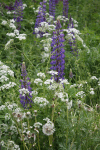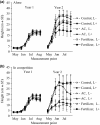Responses of a native plant species from invaded and uninvaded areas to allelopathic effects of an invader
- PMID: 31161023
- PMCID: PMC6540692
- DOI: 10.1002/ece3.5195
Responses of a native plant species from invaded and uninvaded areas to allelopathic effects of an invader
Abstract
Invaders exert new selection pressures on the resident species, for example, through competition for resources or by using novel weapons. It has been shown that novel weapons aid invasion but it is unclear whether native species co-occurring with invaders have adapted to tolerate these novel weapons. Those resident species which are able to adapt to new selective agents can co-occur with an invader while others face a risk of local extinction. We ran a factorial common garden experiment to study whether a native plant species, Anthriscus sylvestris, has been able to evolve a greater tolerance to the allelochemicals exerted by the invader, Lupinus polyphyllus. Lupinus polyphyllus produces allelochemicals which potentially act as a novel, strong selective agent on A. sylvestris. We grew A. sylvestris seedlings collected from uninvaded (naïve) and invaded (experienced) sites growing alone and in competition with L. polyphyllus in pots filled with soil with and without activated carbon. Because activated carbon absorbs allelochemicals, its addition should improve especially naïve A. sylvestris performance in the presence of the invader. To distinguish the allelochemicals absorption and fertilizing effects of activated carbon, we grew plants also in a mixture of soil and fertilizer. A common garden experiment indicated that the performances of naïve and experienced A. sylvestris seedlings did not differ when grown with L. polyphyllus. The addition of activated carbon, which reduces interference by allelochemicals, did not induce differences in their performances although it had a positive effect on the aboveground biomass of A. sylvestris. Together, these results suggest that naïve and experienced A. sylvestris plants tolerated equally the invader L. polyphyllus and thus the tolerance has not occurred over the course of invasion.
Keywords: Anthriscus sylvestris; Lupinus polyphyllus; evolutionary response; invasion; local adaptation; native plant.
Conflict of interest statement
Authors declare no competing interest.
Figures



References
-
- Aniszewski, T. (2007). Alkaloids ‐ Secrets of life: Alkaloid chemistry, biological significance, applications and ecological role (1st ed.). Amsterdam, The Netherlands: Elsevier Science.
-
- Callaway, R. M. , Ridenour, W. M. , Laboski, T. , Weir, T. , & Vivanco, J. M. (2005). Natural selection for resistance to the allelopathic effects of invasive plants. Journal of Ecology, 93, 576–583. 10.1111/j.1365-2745.2005.00994.x - DOI
-
- Fremstad, E. (2010). NOBANIS – Invasive alien species fact sheet – Lupinus polyphyllus . Online Database of the European Network on Invasive Alien Species – NOBANIS. Retrieved from www.nobanis.org
LinkOut - more resources
Full Text Sources
Miscellaneous

